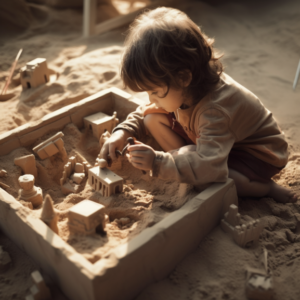Every child carries an invisible backpack, some filled with love and laughter, others weighed down by burdens we can’t see. Trauma in children and adolescents often hides beneath the surface, masquerading as bad behavior, withdrawal, or even excessive shyness.
It’s a silent battle many young individuals face daily without the right tools to articulate or confront their pain.
Did you know that by age 16, more than two-thirds of children report experiencing at least one traumatic event? These invisible scars can shape lives well into adulthood if left unaddressed.
This blog post will provide insights into understanding childhood trauma better and offer guidance on how families and communities can support healing for our kids’ unseen wounds. Get ready to unlock the secrets to mending these broken wings so they can fly high again.
Let’s dive in!
Key Takeaways
- Childhood trauma includes experiences like abuse, neglect, and witnessing violence that can leave deep psychological scars influencing a child’s brain development and behavior.
- Over 60% of adults report having at least one adverse childhood experience (ACE) in their past, highlighting the prevalence of trauma and its potential long-term impact on mental health.
- Addressing childhood trauma is essential for breaking cycles of trauma; it requires recognizing signs, offering a safe space for children to express themselves, and seeking professional help when necessary.
- Therapy and counseling are key techniques in helping children cope with trauma, supporting them to process their feelings safely and build resilience against future stresses.
- Encouraging self-care practices helps children manage stress related to their traumatic experiences, promoting healing and enabling them to develop healthy coping strategies into adulthood.
Understanding Childhood Trauma and its Impact on Mental Health
Childhood trauma can have lasting effects on mental health, influencing brain development and behavior in children and adolescents. It is important to recognize the impact of trauma and take proactive steps to address it.
Definition of Childhood Trauma
Childhood trauma refers to deeply distressing or disturbing experiences that occur during a person’s early years, typically before the age of 18. These traumas can stem from physical, emotional, or sexual abuse, as well as neglect and witnessing violence.
They leave invisible scars that may not be seen but deeply affect a child’s mental health and development.
Traumatic events overwhelm a young person’s ability to cope and react in a healthy way. The impact of childhood trauma often persists into adulthood if left unaddressed, influencing behavior, emotions, and relationships.
It can cause toxic stress which disrupts brain development and the ability to form secure attachments with others. Trauma-informed care is essential for healing these wounds and helping children recover resilience over time.
Statistics and prevalence
Understanding what constitutes childhood trauma helps us grasp its gravity, but it’s the statistics and prevalence that truly illuminate how widespread this issue is. Here’s a closer look at the numbers:
Statistic/Prevalence | Description |
Nearly two-thirds | of children reported at least one traumatic event by age 16. |
1 in 4 | children experiences some form of maltreatment in their lifetime. |
1 in 5 | American children witnesses violence in their family or community annually. |
Increased risk | Children with trauma are at greater risk for mental health disorders, substance abuse, and chronic health conditions. |
ACEs Prevalence | Over 60% of adults report experiencing at least one adverse childhood experience. |
These statistics paint a clear picture of the urgent need for awareness and intervention to protect the mental health and well-being of our children and adolescents. Moving forward, it’s critical to delve into the various types of traumas that these young individuals may face.
Effects on brain development and behavior
Childhood trauma can alter the way a child’s brain develops, sometimes leading to long-term effects on their mental health. During these formative years, traumatic experiences can disrupt the normal progression of brain development and even shrink critical areas responsible for emotion regulation and memory processing.
This impact may manifest in a variety of behavioral issues such as heightened anxiety, trouble with attention and concentration, or difficulty managing emotions.
Behavioral changes often accompany these developmental shifts. A traumatized child might become withdrawn or show aggressive behaviors when feeling threatened. They may struggle forming secure relationships due to trust issues stemming from past adverse childhood experiences (ACEs).
Without proper support and trauma-informed care, these invisible scars can carry into adulthood, affecting personal relationships and overall well-being. It is vital not just to heal wounds of childhood trauma but also to understand how they shape behavior and personality over time.
Types of Childhood Trauma
Types of childhood trauma include physical, emotional, and sexual abuse, neglect, and adverse childhood experiences (ACEs). Each type can have long-lasting effects on a child’s mental and emotional well-being.
Physical, emotional, and sexual abuse
Children and adolescents who have experienced physical, emotional, or sexual abuse may struggle with feelings of fear, guilt, and shame. These forms of trauma can significantly impact their mental health and well-being, leading to a range of emotional and behavioral challenges.
It’s important to create a safe environment where they feel comfortable expressing themselves without judgment.
Recognizing the signs of abuse is crucial in providing timely support and intervention for these young individuals. Professional help should be sought to address the immediate effects of trauma while also promoting long-term healing and recovery.
Neglect
After addressing physical, emotional, and sexual abuse, it’s essential to acknowledge the equally damaging impact of neglect on a child’s well-being. Neglect occurs when a child’s basic needs for food, shelter, clothing, education, and emotional support are consistently unmet.
It can lead to malnutrition, poor hygiene practices, lack of supervision, or emotional detachment from caregivers. This form of trauma can have profound effects on a child’s development and mental health.
Experiencing neglect during childhood can result in long-term consequences such as impaired brain development and attachment issues. Children who endure neglect may struggle with forming secure relationships and coping with stress in their adult lives.
Adverse childhood experiences (ACEs)
Following neglect, adverse childhood experiences (ACEs) encompass a broad range of traumatic events that occur during a person’s upbringing, often leading to long-term consequences.
ACEs may involve physical, emotional, or sexual abuse, as well as household dysfunction such as substance abuse or mental illness among caregivers. These experiences can create toxic stress and impact the child’s brain development and overall well-being.
The effects of ACEs can manifest in various forms including behavioral problems, health issues, and difficulties in forming healthy relationships. It is crucial to recognize these experiences early on and provide children with the necessary support to prevent lasting psychological scars.
Identifying and Addressing Childhood Trauma in Children and Adolescents
Recognizing signs and symptoms, providing a safe environment, and seeking professional help are crucial in addressing childhood trauma. To learn more about how to support children and adolescents who have experienced trauma, continue reading our blog.
Recognizing signs and symptoms
- Observe changes in behavior, such as increased anger, aggression, or withdrawal.
- Pay attention to physical symptoms like headaches, stomach aches, or other unexplained pains.
- Watch for sudden changes in academic performance or disinterest in activities once enjoyed.
- Notice difficulties with sleep patterns, including nightmares or trouble falling asleep.
- Be aware of heightened anxiety, hypervigilance, or constant worry.
- Look out for regressive behaviors like bedwetting or clinging to caregivers.
- Take notice of self-destructive behaviors such as self-harm or substance abuse.
Providing a safe and supportive environment
Creating a safe and supportive environment for children and adolescents who have experienced trauma is crucial for their healing process. Encouraging open communication and actively listening to their feelings can help them feel understood and valued.
Establishing predictable routines, setting clear boundaries, and offering reassurance can provide a sense of safety and stability. Additionally, nurturing trusting relationships with caregivers, teachers, or mental health professionals can cultivate a secure attachment that promotes resilience in the face of adversity.
Ensuring physical safety by creating a secure physical environment free from potential triggers is paramount in supporting traumatized children. Empowering them to express themselves through creative outlets such as art, music, or writing can offer therapeutic benefits while promoting self-expression and emotional release.
Seeking professional help
When dealing with childhood trauma, it is crucial to seek professional help. Professional therapists and counselors can provide specialized support that allows children and adolescents to process their experiences in a safe and structured environment.
Seeking professional help also ensures access to evidence-based treatments tailored to the individual’s needs, promoting healing, and fostering resilience.
Trauma-informed care from mental health professionals helps individuals address the impact of childhood trauma, develop coping strategies, and build healthy relationships. Additionally, seeking professional help contributes to breaking the cycle of trauma by providing children with the tools they need to navigate their emotions and experiences effectively.
Techniques for Coping with Childhood Trauma
Coping techniques for childhood trauma include therapy and counseling, building resilience and coping skills, and engaging in self-care practices. These methods can help children and adolescents process their experiences and develop healthy ways of managing their emotions.
Therapy and counseling
Therapy and counseling provide children and adolescents with a safe space to process their experiences, express their emotions, and learn healthy coping strategies. Trained professionals use evidence-based techniques such as cognitive-behavioral therapy (CBT) and play therapy to help individuals work through trauma-related symptoms.
By participating in therapy, children can develop a better understanding of their feelings and behaviors while building resilience to overcome challenges.
Counseling sessions aim to empower children by providing them with tools to manage stress, regulate emotions, and improve interpersonal relationships. Therapy interventions also focus on fostering a sense of safety and trust while promoting healing from past traumatic experiences.
Building resilience and coping skills
Children and adolescents can develop resilience by engaging in various activities that promote emotional strength and coping skills. This includes participating in sports, creative arts, or community service to foster a sense of belonging and purpose.
Additionally, practicing mindfulness through meditation or deep breathing exercises can help manage stress and regulate emotions. Encouraging positive social connections with family members, friends, or mentors also plays a crucial role in building resilience against the impact of childhood trauma.
By focusing on developing coping strategies like seeking professional support when needed and nurturing healthy relationships, children can enhance their ability to navigate challenging experiences and thrive despite adversity.
Engaging in self-care
Taking care of oneself is crucial in healing from childhood trauma. Engaging in self-care activities like exercise, meditation, or hobbies can help manage stress and anxiety. Creating a safe space for self-care can empower individuals to cope with the lingering effects of trauma on their mental health.
Practicing mindfulness and focusing on personal well-being enables individuals to build resilience and develop healthy coping mechanisms against the long-term impacts of childhood trauma.
Taking time for self-care helps in reclaiming a sense of control over one’s emotional and psychological well-being, fostering healing and growth towards a brighter future.
The Importance of Addressing Childhood Trauma in Society
Addressing childhood trauma in society is crucial for breaking the cycle of intergenerational impact, promoting social and systemic change, and creating a supportive environment for children and adolescents to heal and thrive.
This involves raising awareness, advocating for resources, and implementing trauma-informed practices in various settings.
Impact on future generations
Childhood trauma can leave an enduring mark on future generations, impacting not only the individuals who experienced it but also their offspring. Research indicates that the effects of trauma can be passed down through genetic and environmental factors, potentially leading to a cycle of adversity for future children.
Understanding and addressing childhood trauma is crucial in breaking this cycle and preventing its transmission across generations.
Recognizing and providing support for individuals who have experienced childhood trauma can help mitigate its impact on future generations. By creating safe environments, promoting resilience, and offering targeted interventions, society can work towards interrupting the transgenerational transmission of trauma and fostering healthier outcomes for future children.
Addressing social and systemic issues
Having recognized the impact of childhood trauma on future generations, it is imperative to address the social and systemic issues that perpetuate its prevalence. Creating a culture of awareness and support within communities, schools, and healthcare systems is crucial in fostering an environment where children feel safe to express their experiences and seek help without fear or shame.
Additionally, advocating for policies and resources that prioritize trauma-informed care can effectively address the root causes of childhood trauma and provide comprehensive support for affected children.
Promoting societal understanding regarding adverse childhood experiences (ACEs) and investing in early intervention programs can play a pivotal role in breaking the cycle of trauma for future generations.
Promoting awareness and support.
Promoting awareness and support for childhood trauma is crucial. Educating communities about the signs of trauma in children and adolescents can help create a more supportive environment.
Supporting organizations that provide resources for traumatized youth, such as counseling services and safe spaces, contributes to the healing process.
Raising awareness about adverse childhood experiences (ACEs) and their long-term impact on mental health is essential for fostering empathy and understanding in society. Engaging with advocacy groups focused on trauma-informed care also helps influence policy changes to better address the needs of affected individuals.
Conclusion
In conclusion, understanding childhood trauma and its impact on mental health is crucial for providing support to children and adolescents. Recognizing signs of trauma and creating a safe environment are practical steps in addressing the invisible scars left by childhood trauma.
By promoting awareness and support, society can play a significant role in healing these wounds. Furthermore, offering additional resources or guidance can equip individuals with valuable tools to address trauma effectively.
Finally, taking action to address childhood trauma not only benefits the current generation but also lays the foundation for healthier future generations.
